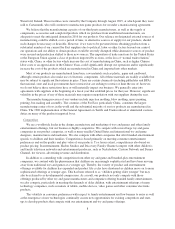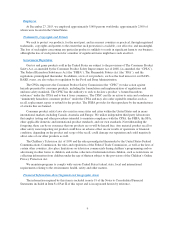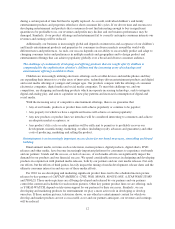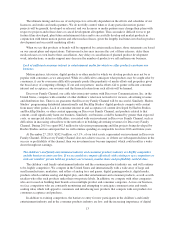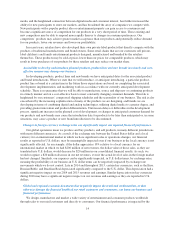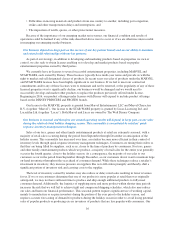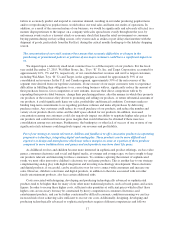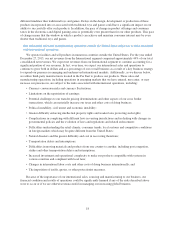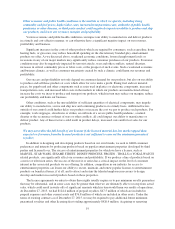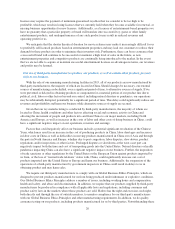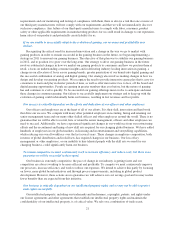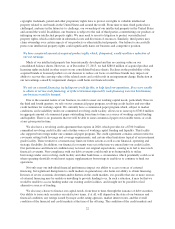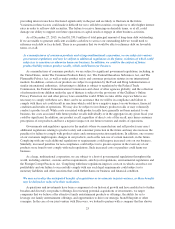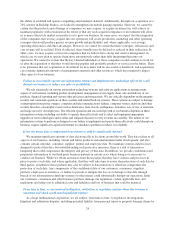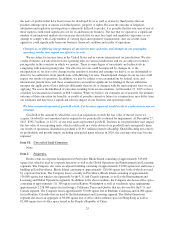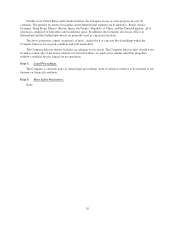Hasbro 2015 Annual Report Download - page 29
Download and view the complete annual report
Please find page 29 of the 2015 Hasbro annual report below. You can navigate through the pages in the report by either clicking on the pages listed below, or by using the keyword search tool below to find specific information within the annual report.different timelines than traditional toys and games. Delays in the design, development or production of these
products incorporated into or associated with traditional toys and games could have a significant impact on our
ability to successfully offer such products. In addition, the pace of change in product offerings and consumer
tastes in the electronics and digital gaming areas is potentially even greater than for our other products. This pace
of change means that the window in which a product can achieve and maintain consumer interest may be even
shorter than traditional toys and games.
Our substantial sales and manufacturing operations outside the United States subject us to risks associated
with international operations.
We operate facilities and sell products in numerous countries outside the United States. For the year ended
December 27, 2015, our net revenues from the International segment comprised approximately 44% of our total
consolidated net revenues. We expect net revenues from our International segment to continue accounting for a
significant portion of our revenues. In fact, over time, we expect our international sales and operations to
continue to grow both in dollars and as a percentage of our overall business as a result of a key business strategy
to expand our presence in emerging and underserved international markets. Additionally, as we discuss below,
we utilize third-party manufacturers located in the Far East to produce our products. These sales and
manufacturing operations, including operations in emerging markets that we have entered, may enter, or may
increase our presence in, are subject to the risks associated with international operations, including:
• Currency conversion risks and currency fluctuations;
• Limitations on the repatriation of earnings;
• Potential challenges to our transfer pricing determinations and other aspects of our cross border
transactions, which can materially increase our taxes and other costs of doing business;
• Political instability, civil unrest and economic instability;
• Greater difficulty enforcing intellectual property rights and weaker laws protecting such rights;
• Complications in complying with different laws in varying jurisdictions and in dealing with changes in
governmental policies and the evolution of laws and regulations and related enforcement;
• Difficulties understanding the retail climate, consumer trends, local customs and competitive conditions
in foreign markets which may be quite different from the United States;
• Natural disasters and the greater difficulty and cost in recovering therefrom;
• Transportation delays and interruptions;
• Difficulties in moving materials and products from one country to another, including port congestion,
strikes and other transportation delays and interruptions;
• Increased investment and operational complexity to make our products compatible with systems in
various countries and compliant with local laws;
• Changes in international labor costs and other costs of doing business internationally; and
• The imposition of tariffs, quotas, or other protectionist measures.
Because of the importance of our international sales, sourcing and manufacturing to our business, our
financial condition and results of operations could be significantly harmed if any of the risks described above
were to occur or if we are otherwise unsuccessful in managing our increasing global business.
18


